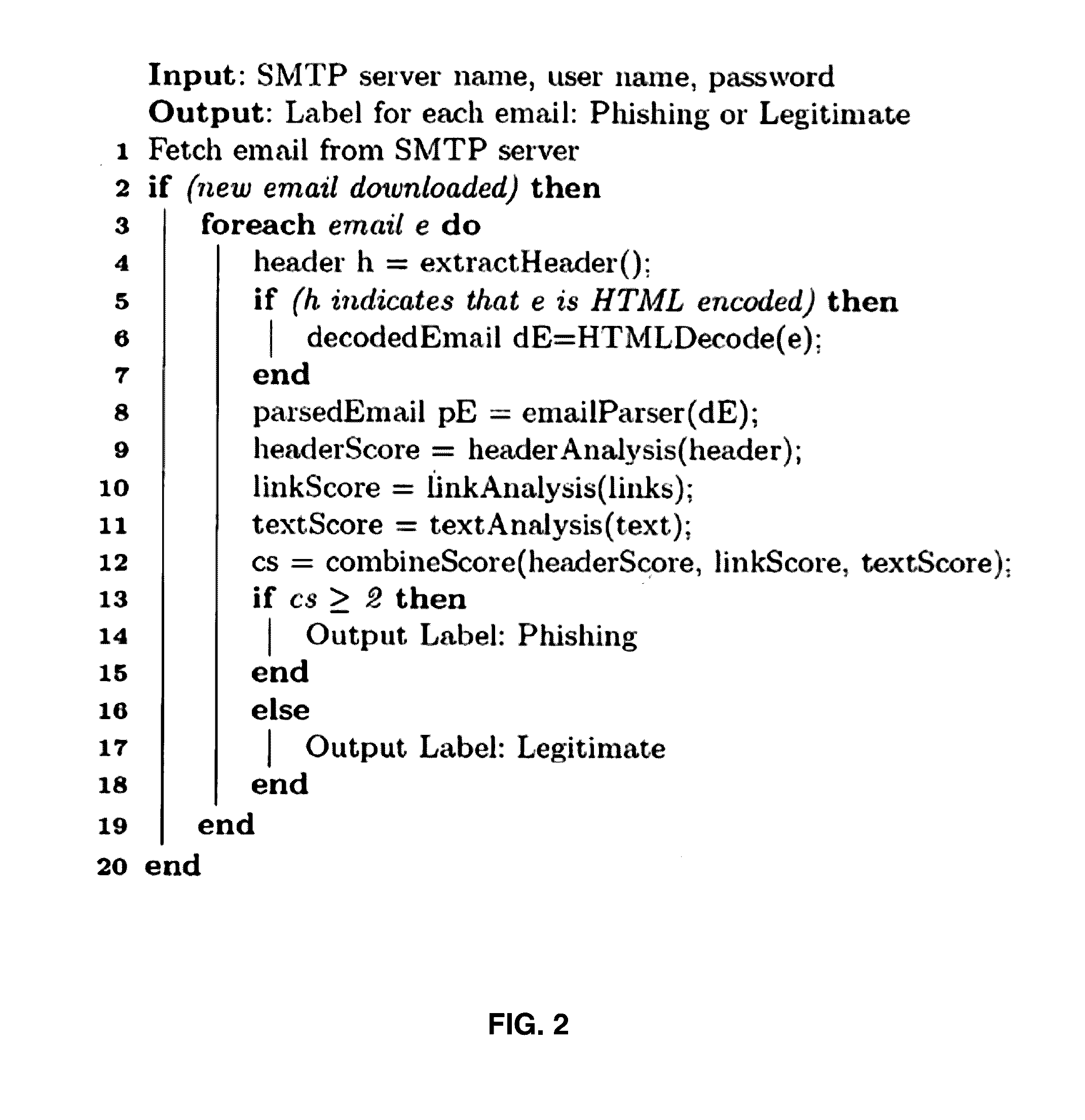Automatic Phishing Email Detection Based on Natural Language Processing Techniques
a technology of automatic phishing email detection and natural language processing, applied in the field of cyber security, can solve the problems that none of the detection schemes available in the literature seem to make use of this distinction to detect phishing emails, and the natural language processing (nlp) by computers is well recognized to be a very challenging task, so as to improve the performance of phishing classifiers, minimize detection time, and save bandwidth
- Summary
- Abstract
- Description
- Claims
- Application Information
AI Technical Summary
Benefits of technology
Problems solved by technology
Method used
Image
Examples
example 1
[0126]Consider a phishing email in which the bad link, deeming the email phishing, appears in the top right-hand corner of the email and the email (among other things) directs the reader to “click the link above.” The score of verb v.epsilon.SV being score (v)={1+x(l+a)} / 2.sup.L. The parameter x=1, if the sentence containing v also contains either a word from SA.orgate.D and either a link or the word “url,”“link,” or “links” appears in the same sentence, otherwise, x=0. The parameter l=2, if the email has two or more links, l=1 if the email has one link, and l=0 if there are no links in the email. The parameter a=1 if there is a word from U or a mention of money in the sentence containing v, otherwise a=0. Money is included for illustrative purposes since phishers often lure targets by promising them a sum of money if they complete a survey or by stating that someone tried to withdraw a sum of money from the user's bank account recently, etc. The parameter L is the level of the verb...
example 2
[0152]With search engines rate-limiting queries and charging for them, methods based on Web search may be relatively limited. The hypothesis is that obfuscation techniques used by phishers to fool people skew the character distributions in the phishing URLs. The features were built on this idea. More verification of this underlying hypothesis was done. Researchers in have used a bag of words representation of binary features to classify URLs. A hypothesis is made that there may be certain information not captured by this approach in the underlying character distributions. A collection of N-gram character frequencies is proposed to be used instead of a bag of words. The N represents the length of the character substring. Character N-Grams. Researchers have previously used normalized English single-letter frequencies in a URL as a collection of features for their phishing URL classier. Since this could be easy to evade, This idea is generalized by expanding to include the...
example 3
Header Analysis of Emails
Header Domains
[0169]The header fields concerned with the transfer and delivery of the emails mostly contain the name of the domain of each mail client and server that it passes through. For example in the ‘From’ field address a@sender.com, ‘sender.com’ is the domain name. These domains are extracted from all the fields which contain such information and are collectively addressed as ‘Header domains’ in the paper.
Message-ID
[0170]RFC 2822 states that each email must have a globally unique identifier called Message-ID. If this is included it must be in the email header. RFC 2822 also defines the syntax of Message-ID. It should be like a legitimate email address and it must be included within a pair of angle brackets. A typical Message-ID looks like the following: . According to RFC 2822, Message-ID can appear in three header fields. They are Message-ID header, in-reply-to header and references header. But Message-ID of the present email must be included against...
PUM
 Login to View More
Login to View More Abstract
Description
Claims
Application Information
 Login to View More
Login to View More - R&D
- Intellectual Property
- Life Sciences
- Materials
- Tech Scout
- Unparalleled Data Quality
- Higher Quality Content
- 60% Fewer Hallucinations
Browse by: Latest US Patents, China's latest patents, Technical Efficacy Thesaurus, Application Domain, Technology Topic, Popular Technical Reports.
© 2025 PatSnap. All rights reserved.Legal|Privacy policy|Modern Slavery Act Transparency Statement|Sitemap|About US| Contact US: help@patsnap.com



